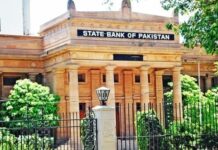ISLAMABAD: The State Bank of Pakistan (SBP) says the small and medium enterprises (SME) borrowing showed 19.7% growth during the fourth quarter of the fiscal year 2020-21, which stood at Rs524.1 billion, WealthPK reported.
According to an SBP report released in March 2022, the SMEs borrowing showed 19.7% growth, private sector credit to SMEs depicted 7.8% growth, and SME financing by Islamic banks and Islamic banking divisions showed 7.3% growth in the fourth quarter of FY21.
The year-on-year (YoY) data of outstanding SMEs finance showed an upsurge to Rs524.09 billion in December 2021 from Rs481.78 billion in the corresponding period of 2020. Domestic private sector financing also increased from Rs6.625 trillion in December 2020 to Rs8.051 trillion in December 2021, and the non-performing loans (NPLs) ratio of SMEs exhibited a minor rise from 15.62% in December 2020 to 15.85% in December 2021, reported WealthPK.
On the other hand, private sector financing to SMEs declined from 7.27% in December 2020 to 6.51% in December 2021. The SMEs’ facility-wise composition was Rs524.09 billion in December 2021, which is higher as compared to the Rs481.78 billion in the same period last year. It includes fixed investment, working capital, and trade finance.
The YoY fixed investment also showed an augmented value of Rs130.45 billion as compared to Rs114.02 billion during the same period of last fiscal year. Working capital improved to Rs351.61 billion in December 2021 from Rs325.46 billion in December 2020. Trade finance showed a minor cut from Rs42.28 billion to Rs42.04 billion during the period under review.
The quarter-on-quarter (QoQ) data of fixed investment showed growth from Rs118.72 billion to Rs130.45 billion, working capital climbed from Rs277.29 billion to Rs351.61 billion, and trade finance for SMEs amplified from Rs41.70 billion to Rs42.04 billion from Sept-Dec 2021. The sector-wise financing of SMEs has shown a rise to Rs524.09 billion in December 2021 as compared to Rs481.78 billion in the corresponding period of 2020.
Considering the YoY data, trading SMEs increased from Rs160.34 billion in Dec 2020 to Rs181.12 billion in December 2021. The manufacturing SMEs also increased to Rs225.57 billion in December 2021 from Rs202.64 billion in December 2020. Service sector showed a decline to Rs117.41 billion in December 2021 compared to the same period of 2020 that was Rs118.80 billion, reported WealthPK.
The quarterly data showed trading SMEs’ growth to Rs181.12 billion in December 2021 from Rs167.6 billion in September 2021. Manufacturing SMEs showed a high growth up to Rs225.57 billion from Rs156.25 billion, and the services SMEs increased to Rs117.41 billion from 113.80 billion during the period under review.
The report showed that all-time high financing was achieved in SMEs in the banking history. This increased financing is a result of the policies of the SBP including credit guarantees and long-term financing. The SMEs Asaan Finance launched in August 2021 by the SBP is also contributing to enhancing the lending to SMEs.
The SMEs sector has a vital role in the economy of Pakistan as they generate employment for a large number of people. It constitutes almost 90% of the Rs3.2 million total business and contributes about 40% to gross domestic product (GDP) and 25% to export profits, according to a report of Small and Medium Enterprise Development Authority (SMEDA).
In Pakistan, a time-consuming system, high cost of financing and high collateral basis for providing loans by banks hinder the SMEs in obtaining loans from financial institutions. Therefore, SMEs prefer the informal sector as an easy way to get loans. The high costs also act as a hurdle in swift growth.
The State Bank launched the SMEs Asaan Finance (SAAF) scheme in August 2021 to enhance credit to SMEs. It provides loans to SMEs without any collateral. The SMEs that are unable to pay collateral are also getting finance up to Rs10 million at a low rate of 9 percent. It will help them meet their long-term and short-term needs. -INP





